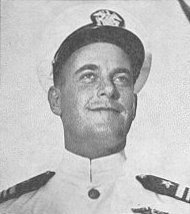| |

Image copyright USNI
Rear Admiral Richard Hetherington O'Kane
February 2, 1911 - February 16, 1994
Richard Hetherington O'Kane was born in Dover,
New Hampshire on February 2, 1911, son of Dr. Walter Collins O'Kane and
Mrs. (Clifford Hetherington) O'Kane. He attended Phillips Academy,
Andover, New Hampshire and the University of New Hampshire at Durham, before
entering the U.S. Naval Academy, Annapolis, Maryland on appointment from
his native state in 1930. He was graduated and commissioned Ensign
on May 31, 1934.
Following graduation he served a year in USS CHESTER
and then two more years in USS PRUITT before reporting in January 1938
for instruction in submarines at the Submarine Base, New London, Connecticut.
After completing his training in June 1938, he served in the submarine
USS ARGONAUT until April 1942, when he reported for duty in connection
with fitting out the USS WAHOO at the Navy Yard, Mare Island, California.
He served as Executive Officer of that submarine from her commissioning,
May 15, 1942 until July 1943, being detached before she was announced overdue
and presumed lost in November 1943. For outstanding service in the
WAHOO, he was awarded the Silver Star Medal with two gold stars in lieu
of a Second and Third Silver Star Medal and a Letter of Commendation, with
authorization to wear the Commendation Ribbon from the Secretary of the
Navy. He was also entitled to the Ribbon for, and a facsimile
of, the Presidential Unit Citation awarded the USS WAHOO.
In August 1943 he returned to the Mare Island Naval
Shipyard where the USS TANG was building. He assumed command of that
submarine upon her commissioning on October 15, 1943. After intensive
training excersizes in the San Diego area the USS TANG left for the Pacific,
arriving in Pearl Harbor on January 8, 1944. He commanded USS TANG
during four highly successful war patrols. He was awarded the Navy
Cross, Gold Stars in lieu of a Second and Third Navy Cross and the Legion
of Merit with Combat "V" for rescuing twenty-two downed U.S. naval aviators.
TANG's fifth war patrol began on September 24, 1944
and ended October 25, 1944. Having expended all but two of his torpedoes
against enemy shipping TANG fired her two remaining torpedoes at a crippled
transport. The first ran true to the target but the second torpedo
ran erratically and started a circular run. Emergency speed was called
for but twenty seconds after firing the malfunctioning torpedo hit the
stern of TANG and she sank immediately.
Commander O'Kane was rescued by a small Japanese
man o'war and imprisoned on Formosa. He was later transferred to
a secret prison camp near Tokyo, Japan where he was not registered.
Therefore he was carried on the Navy's records as Missing In Action until
his liberation following the cessation of hostilities. He was evacuated
by air to the Naval Hospital in Portsmouth, New Hampshire.
President Truman presented the Medal of Honor, awarded
by Congress, to Commander O'Kane at the White House on March 27, 1946.
The TANG received two Presidential Unit Citations for outstanding performance
in combat (1) during her First, Second and Third War Patrols and (2) for
her Fourth and Fifth War Patrols. Richard H. O'Kane was the highest
scoring submarine commander of World War II.
In April 1946 he joined the Staff of Commander Mare
Island Group, Pacific Reserve Fleet, with additional duty as Commanding
Officer of the USS PELIAS. In the assignment that extended to July
1948, he attended and testified at the War Crimes Trials in Tokyo, Japan
in September-October 1947. He next served for a year as Executive
Officer of the USS NEREUS, based at San Diego, and in August 1949, became
Commander Submarine Division THIRTY-TWO. He was a student at the
Armed Forces Staff College, Norfolk, Virginia from August 1950 until January
1951 then had duty as Instructor in Command Class and Assistant Officer
in Charge of the Submarine School, U.S. Submarine Base, New London, Connecticut.
In July 1952 he became Officer in Charge of that school and was subsequently
promoted to the rank of Captain.
He commanded the USS SPERRY from August 1953 until
June 1954 after which he served as Commander Submarine Squadron SEVEN.
Detached in June 1955, he next had instruction at the Naval War College,
Newport, Rhode Island and in July 1956 was assigned to the Ship Characteristics
Board, Office of the Chief of Naval Operations, Navy Department, Washington,
D.C. He remained there until relieved of active duty pending his
retirement, effective July 1, 1957. At retirement he was advanced
to the rank of Rear Admiral on the basis of combat awards.
In addition to the aforementioned awards, Rear Admiral
O'Kane received the American Defense Service Medal, Fleet Clasp; American
Campaign Medal; Asiatic-Pacific Campaign Medal with one silver and three
bronze stars; World War II Victory Medal; Navy Occupation Service Medal,
Europe Clasp; National Defense Service Medal; Philippine Liberation Ribbon
with two bronze stars; Purple Heart Medal; and the Prisoner of War Medal.
After selecting early retirement from active duty,
Rear Admiral O'Kane worked for Great Lakes Carbon Corp. in New York until
1960. He then moved to the Red Hill Horse Ranch in Sebastopol, California
and wrote two best selling accounts of his war experiences;
Clear the
Bridge! in 1977 and WAHOO in 1987.
Rear Admiral O'Kane died on February 16, 1994 and
was buried at Arlington National Cemetery in Virginia. He was survived
by his wife of 57 years, Ernestine and their two children, James H. O'Kane
and Marsha O'Kane Allen. In December 1994 the Navy named its newest
ARLEIGH BURKE Class Destroyer, DDG-77, the USS O'KANE. |
